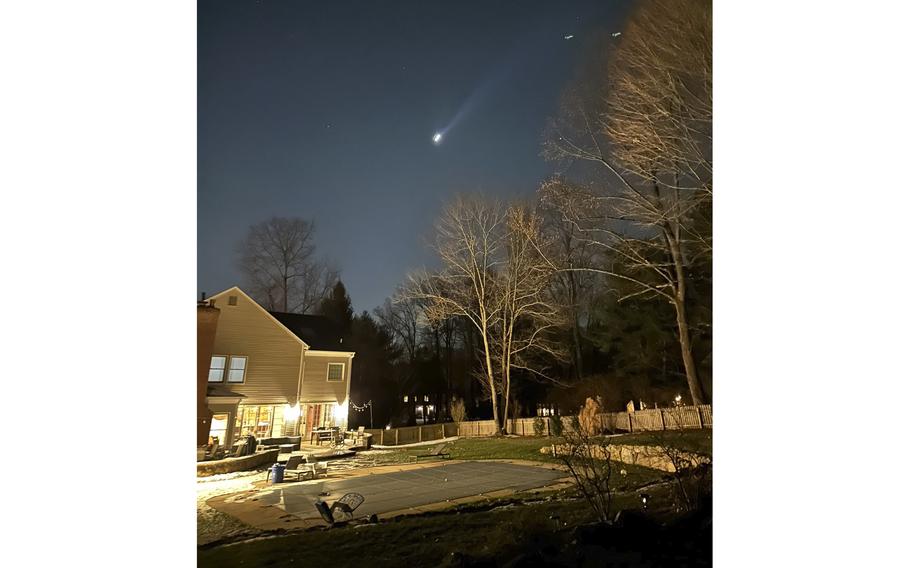
Multiple drones are seen over a suburban home in Bernardsville, N.J., on Dec. 5, 2024. (Brian Glenn/TMX via AP)
The rising panic over mystery drones swarming the skies of Mid-Atlantic states reminds us that, in the centuries-long hunt to identify UFOs, humans are usually the weakest link.
America has real national security challenges in the new era of unmanned aerial vehicles in warfare. But an invasion of mystery drones over New Jersey isn’t one of them.
As it turns out, just as eyewitnesses often bungle the details of, say, a car accident on the corner, we are notoriously unreliable when it comes to identifying and reporting UFOs. A huge percentage of “sightings” turn out, upon investigation, to be the planet Venus or other surprisingly bright astronomical phenomena; people on the ground regularly misjudge distances in the sky so that even objects miles away are perceived to be close by.
The UFO mistaken-identity problem is a big part of the reason that the military and scientists now refer to such sightings more precisely as UAP, or unidentified anomalous phenomena — a label meant to capture that many sightings might not be “objects” at all but are more likely to be known, or as yet unknown, astronomical and atmospheric phenomena.
Even skilled aviators make mistakes. On Oct. 1, 1948, Lt. George Gorman, a World War II veteran and pilot in the North Dakota Air National Guard, gave chase in his P-51 fighter after spotting the bright light of a UFO race past him in the skies over Fargo. At speeds of over 400 mph, he engaged it in a dogfight for nearly 30 minutes, the ball-shaped UFO bobbing and weaving around him as it executed turns that he felt were aerodynamically impossible.
He finally broke off the engagement, never identifying the bogey. “Just when we were about to collide, I guess I got scared,” he told investigators, adding later: “It is hard to believe your own eyes when something with no wings walks off and leaves you standing still.”
Investigators later determined that Gorman had been chasing a weather balloon launched about 10 minutes before he spotted it. The balloon had simply been floating along in the night sky, and he’d been diving and racing all around it.
J. Allen Hynek, the astronomer and godfather of “ufology,” who spent a quarter-century working with the Air Force on its UFO studies and coined the phrase “close encounters of the third kind,” told an interviewer late in his career, “Pilots have been known to swerve their planes violently when they suddenly encounter a very bright meteor they think is on a collision course, but which later proves to have been 50 to 100 miles away.”
There’s a reason people who are serious about studying UAP are trying to get humans out of the reporting loop: At a congressional hearing last summer, Ryan Graves — a former Navy aviator who had his own experiences encountering UAP and now leads an advocacy organization called Americans for Safe Aerospace — proposed a more reliable alternative to the grainy, black-and-white (but supposedly revealing) photos that dot the internet: sensors.
Similarly, Harvard astronomy professor Avi Loeb, one of the leading voices in UAP studies, argues that we need to far better understand what a “regular” sky looks like before trying to determine what’s “anomalous.” As Loeb told me last year: “Trust in data. People are a waste of time.”
I’ve always been fascinated by the self-centered confidence that underlies so many UFO reports, that people’s first instinct upon spotting a bright, moving light in the night sky is not to assume the obvious — say, a star, meteor, satellite or faraway jetliner — but instead to imagine that, after an alien craft journeyed thousands of light-years across interstellar space to visit Earth, the aliens would pick that moment on a random Tuesday night to reveal themselves to someone on a dark, rural road or in a suburban backyard. Occam’s razor, the useful medieval theory that argues the simplest explanation is usually the best, would tell you that the sound of hoofbeats more likely means horses than zebras.
Partly, that instinct stems from something fundamental. The question “Are we alone?” is one of the three most basic questions that have fascinated humans since the first caveman campfires, a question that ranks alongside “What happens after death?” and “Is there a God?” as the most profound and potentially life-altering mysteries we wrestle with. Who wouldn’t want to knock out an answer to one of the Big Three while taking out the garbage late at night?
Beyond that, our cultural fascination with UFOs stems from the fact that it is a rare area where we can all gaze upon the deepest frontier of knowledge. As an ordinary person, I can’t add much to the already-advanced scientific and mathematical questions of our time: I’m not liable to crack string theory wide open during a weekend barbecue, nor is my tinkering in the garage likely to deliver to humanity the secret to nuclear fusion.
And yet, as the New Jersey drone mystery reminds us, every time any of us looks out the kitchen window, glances into the backyard sky or drives down an empty highway, we can believe we might see that one glowing light that changes everything.
Garrett M. Graff, a Washington Post contributing columnist writing about leadership, is a journalist, historian and author of nine books, including “Watergate: A New History.”